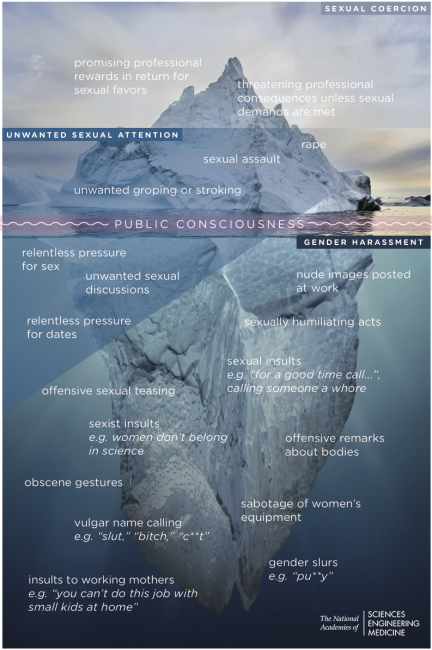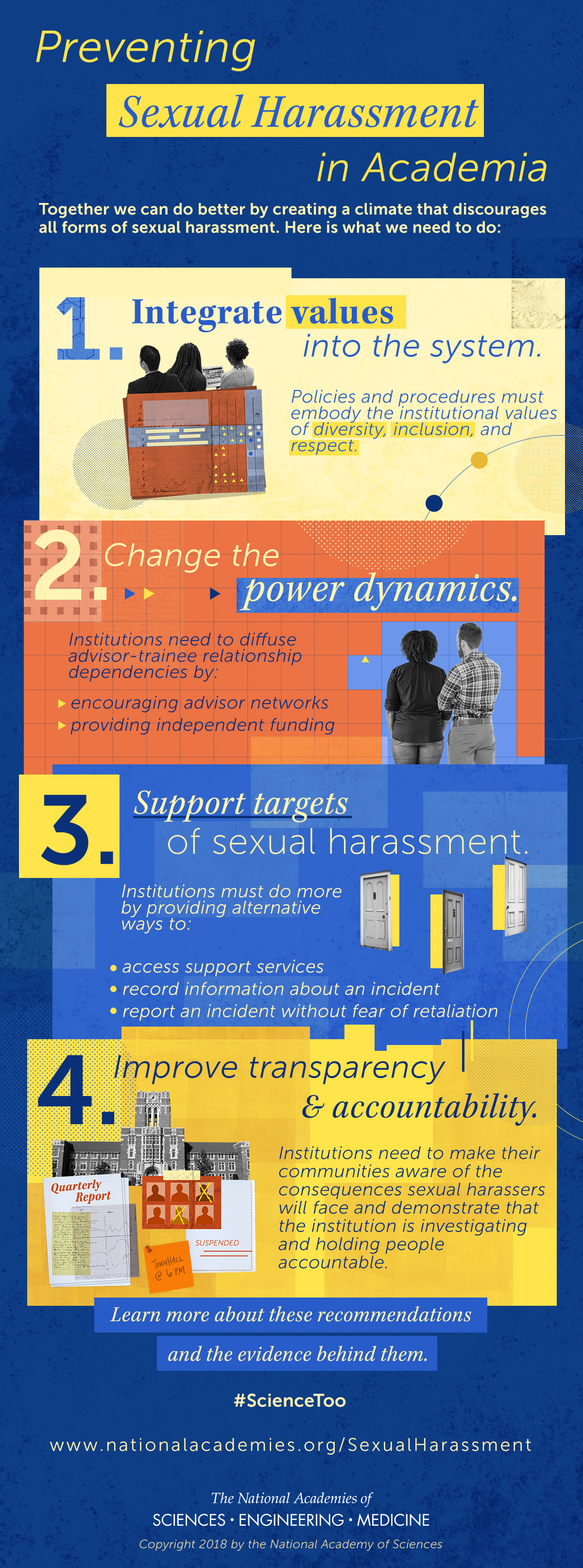You have /5 articles left.
Sign up for a free account or log in.

National Academies of Sciences, Engineering and Medicine
Reports of sexual harassment in academe may be on the rise, but there’s no evidence to suggest that harassment itself is declining. To effect real change, colleges, universities and research centers must move beyond treating harassment like a legal problem and treat it like a cultural one -- one with major implications for institutional and scientific excellence.
So said a group of science leaders Tuesday during a news briefing on a highly anticipated report from the National Academies of Sciences, Engineering and Medicine. The report pertains to those fields in particular, but its conclusions resonate more broadly in the midst of the Me Too movement -- a fact of which the report’s authors were keenly aware.
Frazier Benya, program officer with the academies’ Committee on Women in Science, Engineering and Medicine and study director, said she and her colleagues knew that the scientific community would be watching when they began their work two years ago. “What we didn’t know," she continued, "is that the eyes of the nation would also be upon this study, as a result of so many things that have transpired since."
Benya said she hoped the study, now concluded, would help lead to "necessary change," in academe and beyond.
Indeed, if enacted on a broad scale, some of the recommendations included in the report could make academic science -- a place where women historically have been unwelcome -- a national leader in curbing harassment.
Recommendations include treating sexual misconduct as seriously as research misconduct in its effect on research, welcoming women to all stations of campus leadership and diffusing power hierarchies. The latter might be accomplished by moving away from a single adviser-advisee model to one in which students are advised by a group of mentors, and in which graduate students' funding is tied to the department instead of a single faculty member, the study says. In many cases, graduate students who have eventually reported harassment said they felt strong pressure not to compromise a relationship with a key adviser or a principal investigator whose grants provided them funding, even when the relationship was abusive.
To be effective, antiharassment training must focus on changing behaviors, not attitudes, the report says. It must also reflect what sexual harassment actually looks like. Contrary to popular assumptions, it is not most commonly quid pro quo sexual harassment or sexual coercion, or unwanted sexual advances -- although both phenomena are harassment and sometimes rise to the level of criminal sexual assault.
Rather, the most typical kind of harassment in academe is gender-based harassment, or disparagement on the basis of sex -- comments such as “Women don’t belong in science.” And because most harassment does not get reported, colleges and universities should offer targets of harassment multiple avenues to share their concerns and seek support, the report says. It suggests that institutions have a private ombudsperson to counsel those who have been harassed, apart from offices that comply with Title IX of the Education Amendments of 1972, which prohibits gender discrimination.
Above all, institutions should try to promote cultures of respect so that harassment is less likely to occur in the first place, the study urges.
Legal remedies such as investigations under Title IX, should be "a floor, not the ceiling for what universities should do,” said committee member Lilia Cortina, professor of psychology, women’s studies and management and organizations at the University of Michigan.
 Defining the Problem
Defining the Problem
Before making those suggestions, however, the report seeks to define what harassment actually is, the scope of the problem and its effects. It says that sexual harassment is common in academic science, engineering and medicine, with women in academic medicine reporting the highest rates of abuse.
While there is a relative dearth of national data about the exact prevalence of the problem, some 150 institutions already are using a scientifically backed survey tool called the Administrator-Researcher Campus Climate Collaborative Survey, or ARC3. The academies’ report considered data from two large university systems that were willing to share it: the University of Texas and Pennsylvania State University.
The Texas system data, which pertain to recent graduate and undergraduate students, suggest that faculty or staff members have harassed about 20 percent of female science students, more than one-quarter of female engineering students and more than 40 percent of female medicine students. Across Penn State, 33 percent of female undergraduates and 43 percent of female graduate students in all disciplines experienced this kind of harassment. More than 50 percent of female medical students did.
Existing data also suggest that approximately 58 percent of women faculty and staff members across disciplines have experienced sexual harassment. Additional research demonstrates that women of color and/or sexual minority women and gender-nonconforming women experience what Cortina called a “double whammy” of harassment.
What predicts harassment? Beyond male-dominated environments, both Cortina and the report say organizational climate is the single most important factor. Potential harassers will act out more in cultures or climates they see as permissive, and academe has a reputation as such a permissive place. Moreover, the report says, when gender harassment is pervasive, both unwanted sexual advances and sexual coercion are more likely to occur. And again -- perhaps contrary to popular belief -- the least common response to sexual harassment is to formally report it. That’s due to what the report describes a reasonable fear of retaliation. More common reactions to harassment include ignoring or appeasing the harasser and seeking social support.
However women deal with harassment, it affects them. Based in part on data gleaned from interviews with women who had experienced harassment within the last five years, the committee found that misconduct undermines women’s professional and educational attainment and their mental and physical health. Workplace harassment can result in lowered job satisfaction, performance or productivity; increases in stress; or withdrawal from the organization. Students who experience sexual harassment may miss or drop classes, earn lower grades or even drop out. Cortina stressed that witnesses, both men and women -- not just the direct targets of harassment -- feel these effects, as well.
All that amounts to a significant and costly loss to institutions and science over all, committee members said.
“If you care about advancing science, engineering and medicine, you must care about the impact of sexual harassment,” said report co-chair Sheila E. Widnall, Institute Professor and professor of aeronautics and astronautics at the Massachusetts Institute of Technology. "To succeed in making these changes, all members of campuses -- students, faculty, staff and administrators -- will be need to promote an inclusive and respectful environment."
In addition to the report, the committee released a video about its findings and recommendations, available here.
The Work Ahead
Perhaps most importantly, the report says that systems in which there are clear prohibitions against unacceptable behaviors and harassers are held accountable have lower rates of sexual harassment. Policies should be clearly stated and correspond to the severity and frequency of the harassment, the report says. Somewhat controversially, given the thorniness of collegiality as a criterion for tenure and promotion in academe, and the notion of academic freedom, the report also suggests that “cooperation” become a formal part of academic evaluation and reward structures.
Beyond institutions, committee member Billy M. Williams, vice president for ethics, diversity and inclusion at the American Geophysical Union, said professional societies must play a role in ending harassment. The report urges professional societies to “use their influence,” such as taking into account misconduct findings when considering professional awards and establishing codes of conduct for meetings and membership in general.
Responding to a question about enforcement, Bruce Darling, executive officer of the academies, said his more than 100-year-old organization’s bylaws don’t address sexual misconduct. Changing them would entail a two-year process, he said, but the academies are now in talks about establishing some kind of code of conduct. That could include expelling members for certain violations.
The report also urges lawmakers to consider how confidentiality surrounding harassment cases can shield proven harassers from career harm. That’s similar to what U.S. Representative Jackie Speier, a California Democrat, proposed in 2016. Specifically, she asked fellow representatives to pass a law that would require institutions to inform professors’ future workplaces about Title IX findings against them.
Committee member Timothy R. B. Johnson, Arthur F. Thurnau Professor and chair of obstetrics and gynecology and Bates Professor of the Diseases of Women and Children at Michigan, said that while the report is done, the science advocates’ real work lies ahead.
“Our work just begins now,” he said.
The academies’ report is notable in its scope and recommendations, but it’s bolstered by other recent efforts by scientists to end harassment and its deleterious effect on research. The National Science Foundation, for instance, announced in February that institutions will now have to disclose when a principal investigator, co-PI or any other grant “personnel” are found to have committed sexual misconduct or harassment of any kind -- or when the allegations against a PI or co-PI are severe enough to warrant suspension during a campus investigation.





